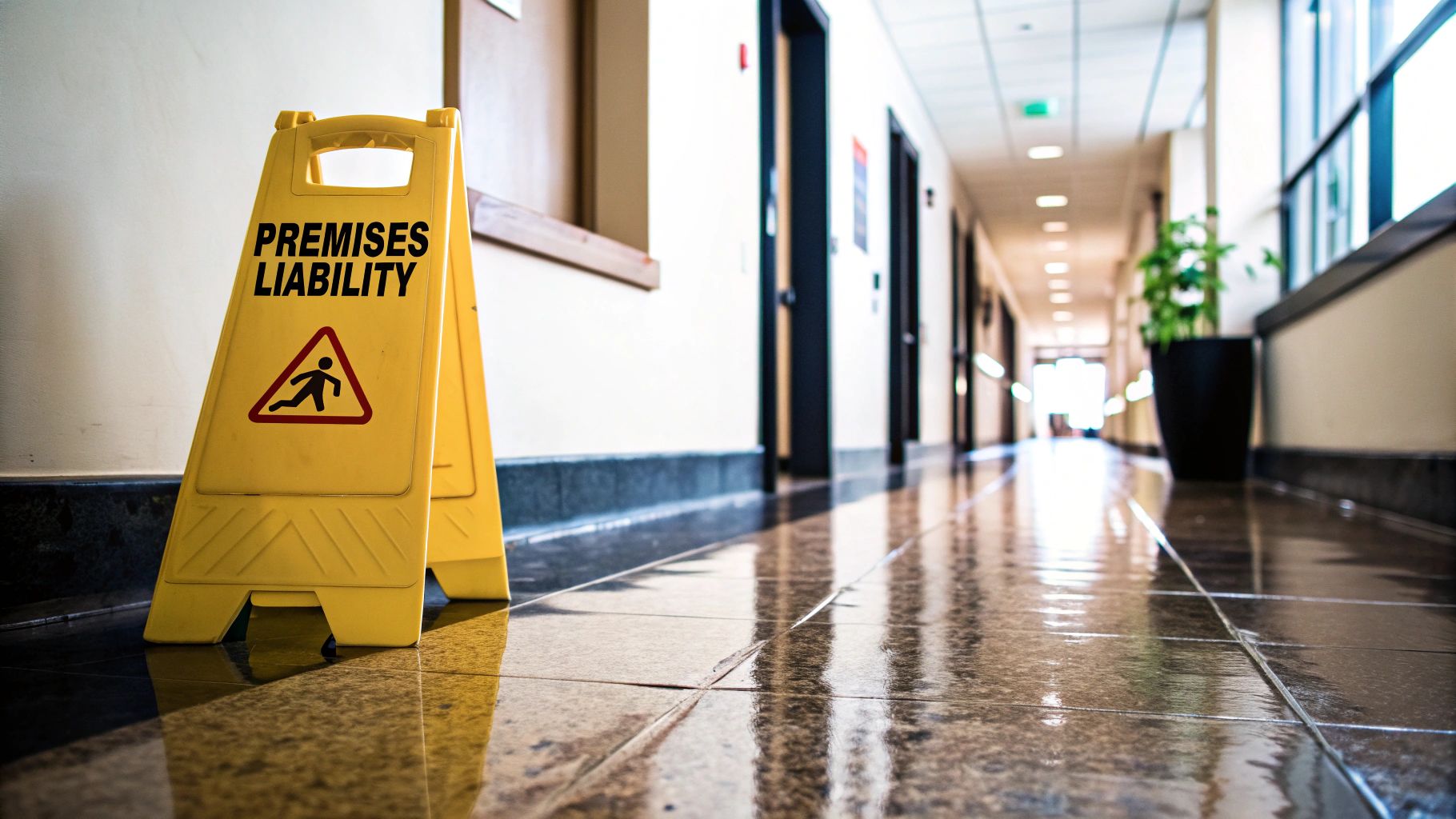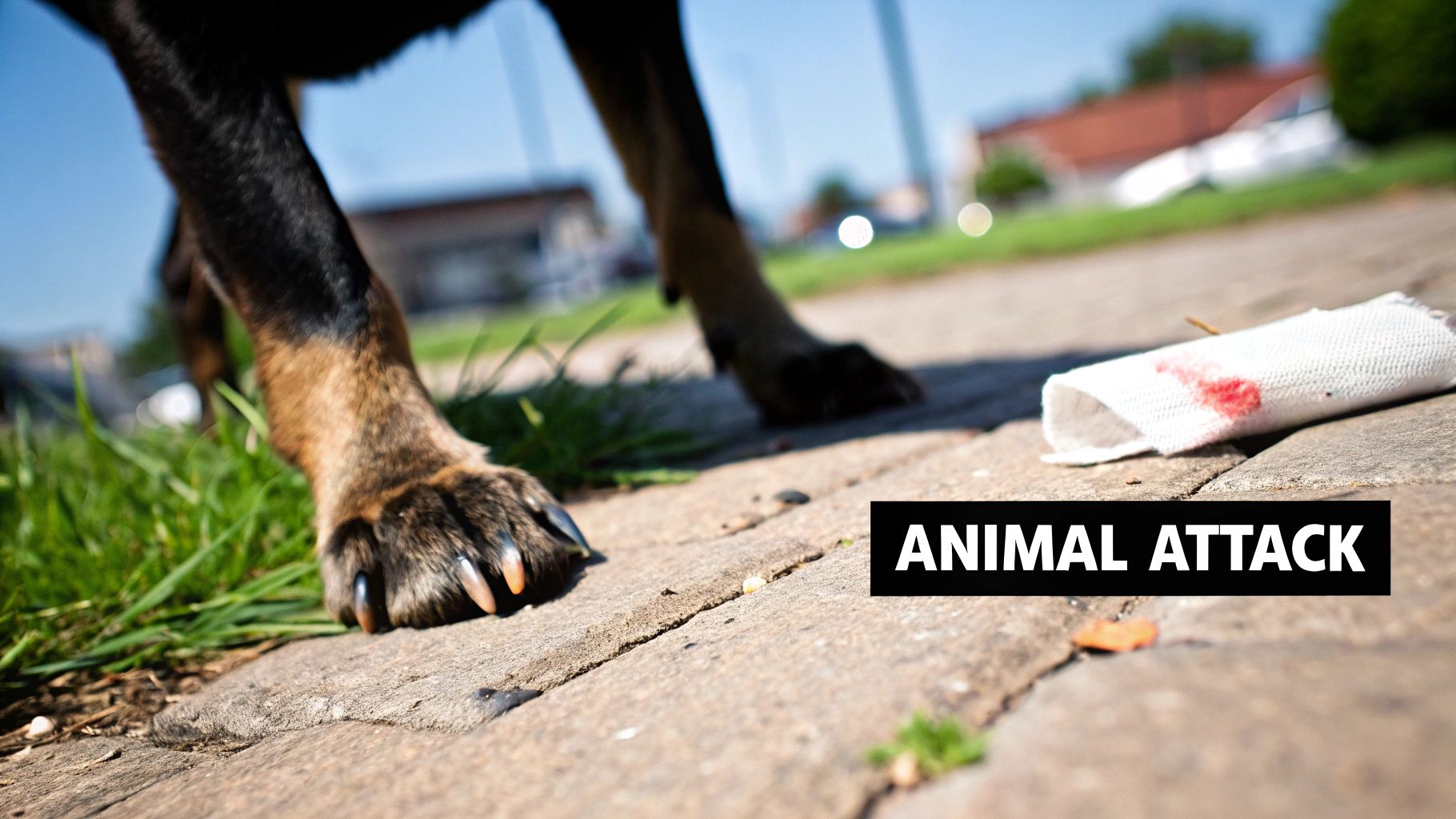Other Blogs
Check out other Legal AI Posts

Discover 6 expert-annotated sample personal injury demand letters. Practical examples to strengthen your claim for car accidents, malpractice, and more.

A well-crafted demand letter is the cornerstone of a successful personal injury claim, setting the stage for negotiations and often determining the final settlement amount. It's your first, and often best, chance to present a compelling, evidence-backed narrative to an insurance adjuster. However, knowing precisely what to include and how to frame it for maximum impact can be a significant challenge.
This guide moves beyond generic templates to provide a detailed, strategic breakdown of effective communication. We have curated six distinct, full-length sample personal injury demand letters, each tailored to a specific case type: from motor vehicle accidents and slip-and-fall incidents to complex medical malpractice and wrongful death claims.
Instead of just showing you a finished product, we will dissect each example to reveal the underlying strategy. You'll gain actionable takeaways and tactical insights into how to structure liability arguments, document damages, and calculate a compelling settlement demand. For legal professionals looking to refine their process, utilizing professionally vetted resources can be a major advantage. To streamline your drafting process and ensure consistency, explore guides on the best templates for legal documents for a solid foundation. These examples provide a replicable blueprint for persuading adjusters and maximizing recovery.
Motor vehicle accidents are the most common type of personal injury claim, making a well-crafted demand letter a critical tool for any practitioner. This letter serves as the foundation of your negotiation, presenting a clear, evidence-backed narrative that establishes the defendant's liability and meticulously details the full extent of your client's damages. The core strategy is to build an undeniable case on paper before ever stepping into a courtroom, compelling the insurance adjuster to offer a fair settlement.
A successful motor vehicle accident demand letter methodically connects the at-fault driver's negligence directly to your client's injuries and financial losses. This involves weaving together police reports, witness statements, traffic citations, and photographic evidence to create a powerful story. For instance, in a rear-end collision case, citing the specific traffic code violation, such as California Vehicle Code § 21703 for following too closely, provides objective proof of liability that significantly strengthens your position.
This infographic summarizes the landscape of motor vehicle accident claims.
The data highlights that while these cases are common, their financial impact, spanning property damage to lost income, dictates the settlement value. A comprehensive demand letter must address each of these damage categories to achieve recoveries in the typical $45,000 to $125,000 range for moderate to severe injuries.
To maximize your letter's impact, organize all supporting documents chronologically and reference them directly within the letter's body. For a deeper dive into structuring your arguments, you can learn more about crafting effective demand letters to get the best outcomes.
Premises liability cases, commonly known as slip and fall claims, require a demand letter that meticulously establishes a property owner's negligence. Unlike a car accident where fault can be more straightforward, this letter must prove the owner knew, or should have known, about a hazardous condition and failed to act. The core strategy is to demonstrate a clear breach of the duty of care owed to your client, leaving the insurance adjuster with little room to dispute liability.

A powerful slip and fall demand letter constructs a narrative that preempts common defenses like blaming the victim for being careless. This is achieved by weaving together evidence such as incident reports, maintenance logs, witness accounts, and especially photographic proof of the hazard. For instance, in a grocery store wet floor case, citing the time the spill occurred versus the time of the fall, supported by surveillance footage or witness statements, can prove the owner had ample "constructive notice" to remedy the danger, a key legal element cited in case law like Ortega v. Kmart Corp. (2001) 26 Cal.4th 1200. This detailed approach is crucial for securing fair settlements, which can range from $32,000 for a wet floor incident to over $89,000 for more severe injuries like those from a stair collapse.
To build an undeniable case, immediately send a spoliation letter to preserve all evidence, including video surveillance and internal incident reports. For additional strategies on building a compelling narrative, you can explore resources on perfecting the premises liability claim. This proactive evidence gathering provides the factual leverage needed for a successful negotiation.
A medical malpractice demand letter is a highly specialized document used in claims against healthcare providers for negligence. Unlike more common personal injury cases, these letters must meticulously prove a breach of the accepted standard of care, requiring extensive medical documentation and expert opinions. The goal is to present an irrefutable, evidence-based argument that connects a provider's deviation from professional norms directly to the patient's catastrophic injuries and damages.
These letters are scientifically precise, serving as a formal notice that establishes the core legal elements: a provider-patient relationship, a breach of the medical standard of care, direct causation of injury, and quantifiable damages. For example, in a surgical error case that resulted in a $1.2 million settlement, the demand letter included a detailed affidavit from a board-certified surgeon who explicitly identified the defendant's procedural mistake and linked it to the client's subsequent organ failure, citing guidelines from the American College of Surgeons to establish the standard of care. Similarly, a misdiagnosis case leading to a $650,000 recovery hinged on demonstrating how a timely, correct diagnosis would have prevented the patient's condition from progressing.

The complexity of these cases, such as a birth injury claim settling for $2.3 million, underscores the need for precision. The high stakes and technical nature mean that a well-supported demand letter can prompt a serious settlement discussion and avoid protracted litigation.
To construct a compelling medical malpractice demand, secure a qualified medical expert before drafting the letter. Their initial review is crucial for validating the claim. Furthermore, focus on creating a clear narrative that simplifies complex medical facts for the insurance adjuster. For guidance on organizing the extensive medical records involved, you can learn more about how to create accurate medical chronology reports for demand letters.
Product liability cases present a unique challenge, as the focus shifts from a single negligent act to the inherent danger of a product itself. A demand letter in these cases must meticulously establish a product's defect, whether in its design, manufacturing, or marketing (failure to warn), and link that defect directly to the client's injury. The core strategy is to assert strict liability, where the manufacturer or seller can be held liable regardless of fault or negligence, a principle that sets these claims apart from standard personal injury cases.
A powerful product liability demand letter builds its case by leveraging technical evidence, expert opinions, and regulatory history. It's not just about telling the story of the injury; it's about proving the product was unreasonably dangerous. For example, in a case involving a defective power tool, the letter would detail not only the injury but also reference consumer complaints, recall notices from the Consumer Product Safety Commission (CPSC) by providing the specific recall number (e.g., CPSC Recall No. 23-123), or expert analysis showing a specific manufacturing flaw, thereby creating an irrefutable link between the product and the harm caused.
The strength of these sample personal injury demand letters often lies in the quality of the evidence gathered. Documenting how a defective airbag deployed improperly, causing severe facial fractures, might lead to a settlement like the $875,000 example, while a pharmaceutical claim backed by extensive FDA data on adverse effects could reach the $1.4 million mark. These outcomes underscore the importance of a well-researched, evidence-heavy approach.
To create a compelling product liability demand letter, you must preserve the defective product in its post-incident condition as it is your primary piece of evidence. Methodically identify and send preservation notices to all parties in the distribution chain to ensure they do not destroy crucial documents or evidence related to the product's design and manufacturing history.
A demand letter for a dog bite or animal attack case requires a unique focus on strict liability statutes and the profound psychological trauma often involved. Unlike many personal injury claims, liability can often be established by simply proving ownership of the animal, as many states hold owners strictly liable for injuries their pets cause. The letter's primary goal is to present an irrefutable link between the owner’s animal and the victim’s severe physical and emotional damages, compelling the homeowner's insurance carrier to settle.

The narrative in these letters must powerfully convey the violent and terrifying nature of the attack. It's not just about the medical bills; it's about the lasting scars, both visible and invisible. For instance, in a case involving child facial scarring that settled for $125,000, the demand letter emphasized the permanent disfigurement and the need for future plastic surgeries and long-term therapy. Citing a specific state statute, like Florida Statutes § 767.04, which imposes strict liability on dog owners, strengthens the claim and leaves little room for the insurer to dispute fault.
The success of these sample personal injury demand letters often hinges on how well they articulate the non-economic damages. A postal worker who recovered $67,000 after an attack had their claim bolstered by detailing how the incident impacted their ability to perform their job duties due to a newfound fear of dogs on their route.
To create a compelling letter, obtain and integrate official reports like those from animal control, as they provide unbiased, third-party validation of the incident. Early verification of the dog owner's homeowner's insurance policy is also critical to confirm coverage for the claim. To see how technology can assist in building these detailed narratives, explore how personal injury lawyers use AI to draft powerful demand letters.
A wrongful death demand letter addresses the most sensitive and financially complex personal injury claims. This document must articulate the profound loss experienced by surviving family members while presenting a rigorous, evidence-based calculation of damages. The core objective is to combine a compassionate narrative of the family's suffering with an irrefutable economic analysis, compelling the defendant's insurer to acknowledge the full value of the life lost and settle the claim fairly.
Unlike other personal injury cases, this letter argues on behalf of the survivors, detailing their losses stemming from the death. It must meticulously connect the defendant’s negligence to the fatality and then translate the immense human and financial void into a specific monetary demand. For example, in a case involving a breadwinner killed in a construction accident, the letter would detail the defendant's specific OSHA violations by citing the regulation code (e.g., 29 CFR 1926.501 - Duty to have fall protection) while presenting an economist's report projecting decades of lost income, benefits, and household contributions, framing the case for a multi-million dollar recovery.
The gravity of these cases, such as a medical malpractice death resulting in a $1.9 million settlement or a construction fatality recovering $3.4 million, underscores the necessity of a thorough demand letter. The letter must address both the wrongful death claim (survivors' losses) and any potential survival action (the deceased's pre-death pain and suffering), as allowed by state statutes.
To create a powerful wrongful death demand, work closely with a forensic economist to project future earnings and the value of household services accurately. For a deeper understanding of how to structure these complex claims and present compelling evidence, you can learn more about the essential components of a wrongful death claim.
Demand Letter TypeImplementation Complexity 🔄Resource Requirements ⚡Expected Outcomes 📊Ideal Use Cases 💡Key Advantages ⭐Motor Vehicle Accident Demand LetterModerate - May require experts for complex reconstructionModerate - Police reports, medical docs, employer recordsSettlements typically $45K–$125K; clear liability establishedCar accident claims with physical and property damagesWell-established precedents; objective official evidence; familiar to insurersSlip and Fall Premises LiabilityModerate - Requires gathering premises inspection and witness infoLow to Moderate - Photos, maintenance logs, witness statementsSettlements typically $32K–$89K; depends on proving noticeInjuries due to hazardous property conditionsClear duty of care standards; photographic and code violation evidenceMedical Malpractice Demand LetterHigh - Needs medical expert opinions and detailed causation analysisHigh - Medical experts, extensive medical recordsHigh-value settlements often $650K–$2.3M; complex proof neededHealthcare provider negligence and standard of care violationsHigh damage potential; expert testimony persuasive; clear standardsProduct Liability Defective ProductHigh - Requires technical defect analysis and expert engineeringHigh - Engineering experts, product testingSettlements range $320K–$1.4M; strict liability appliesInjuries caused by defective or dangerous productsStrict liability applies; multiple defendants possible; strong insurance coverageDog Bite and Animal AttackLow to Moderate - Strict liability but requires documentationLow to Moderate - Animal control reports, photosSettlements typically $43K–$125K; emotional distress damages commonAnimal attacks involving dog ownersStrict liability statutes; homeowner insurance coverage often appliesWrongful Death Demand LetterHigh - Complex economic analysis and emotional storytelling requiredHigh - Economic experts, detailed financial recordsVery high settlements $1.9M–$3.4M; damages for survivorsFatal injury claims involving economic loss to familyHighest damage potential; statutory guidance; emotional impact aids settlement
The journey from a blank page to a compelling demand letter can seem daunting, but as the diverse sample personal injury demand letters in this guide illustrate, the core principles remain constant. Each example, from the straightforward motor vehicle collision to the complex wrongful death claim, serves not as a rigid template but as a strategic blueprint. They demonstrate a universal truth: a successful demand is built on a foundation of meticulous documentation, clear narrative, and an authoritative presentation of facts and law.
The true power of these samples lies in understanding the "why" behind each section. The detailed recitation of facts establishes your credibility. The systematic breakdown of medical treatment and expenses substantiates your claims. The poignant description of pain and suffering gives a human voice to the abstract numbers. Mastering this structure is the first step toward transforming your client's story into a persuasive legal argument that an insurance adjuster cannot ignore.
As you move forward, keep these core strategies at the forefront of your drafting process:
Translating these insights into action is what will ultimately drive results. Before you draft your next demand, commit to these practical steps:
Ultimately, a well-crafted demand letter is your firm’s most powerful pre-litigation tool. It sets the tone for negotiations, demonstrates your command of the case, and signals your readiness to advocate fiercely for your client. By internalizing the strategies behind these sample personal injury demand letters, you are not just learning to write a document; you are mastering the art of persuasion that secures the justice and compensation your clients rightfully deserve.
Ready to elevate your demand letter process from a time-consuming task to a strategic advantage? ProPlaintiff.ai uses advanced AI to analyze medical records and generate precise, evidence-based demand letters in a fraction of the time, allowing you to focus on high-value strategy and client advocacy. Discover how firms are achieving better outcomes faster by visiting ProPlaintiff.ai.
Check out other Legal AI Posts
